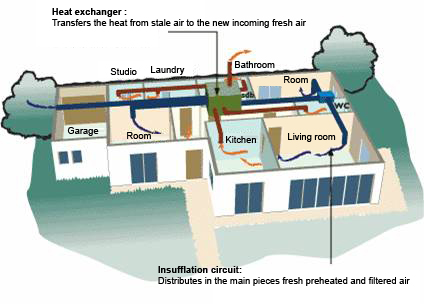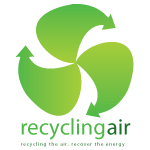
.
Energy Recovery Ventilation (ERV) refers to the recapture of energy typically lost through the building ventilation process. Conditioned air that is routinely being exhausted from both residential and commercial buildings contains significant energy in the form of heat or coolth and humidity which is lost into the exterior environment. As part of a preconditioning process, ERV systems transfer the energy from the exhaust into the incoming air stream, which can also be described in terms of enthalpy. The use of ERV can have significant benefits both directly and indirectly in terms of energy efficiency, indoor air quality, and downsizing of the remaining HVAC equipment.
It is important to note the difference between Energy Recovery Ventilation (ERV) and Heat Recovery Ventilation (HRV). ERV exchanges the total energy (enthalpy) ie both thermal (sensible energy) and humidity (latent energy) between the exhaust and incoming air. HRV only exchanges thermal energy.
ERV systems are gaining popularity for a number of reasons. First, the technology and manufacturing processes are making the systems more affordable. Secondly, increased awareness of energy efficiency and sustainability both for environmental and economic reasons are causing more building operators to request such energy saving measures. Last and perhaps significant, increased ventilation to prevent Sick Building Syndrome (SBS) and promote healthy indoor environments results in a dramatic rise in energy consumption. Heavy ventilation or air changes requires the use of ERV technology, especially in the case of Passive Houses, high LEED certifications and most high performance buildings. In the United States ventilation standards are set by ASHRAE 62 which are used for both LEED and a general standard for high performance buildings. There is a growing body of data to suggest the health benefits of healthy indoor environments and updates to ASHRAE 62 are a recognition of that evolution.
An Opinion on ERV
ERV technology will likely develop further as awareness of occupant health, environmental sustainability, and energy cost grows. Right now we can recover up to 85% of the energy from the exhaust air, maybe in the future it will be possible to recapture even more. Costs will be reduced. The systems will be easier to integrate.
But to me the most exciting aspect of ERV technology is the idea that we can harvest latent, waste energy from our buildings, systems, occupants and environment. Renewable energy sources do roughly the same thing except they recover energy from the largest system of all, the planet itself. Wasting renewable energy supplies is unwarranted but probably inevitable. Entropy will occur in a system, but blatant waste of energy we have already generated elsewhere is shameful. Buildings use energy generated from coal fired plants, and other carbon and pollutant producing sources. This energy pollutes our environment when it is created. Costs real money. And therefore should not be thrown out into the environment. On a larger scale, projects like the Zollverein School and Hammarby Sjostad are have started to engage the idea that buildings can recover waste heat energy but the technology has not advanced far enough.
Who knows, maybe an adoption of ERV systems will cause a sea-change in the way people think about energy.









 KlimaHouse
KlimaHouse LifeBreath
LifeBreath Mitsubishi electric
Mitsubishi electric sanuvox
sanuvox Amatrice – Club Alpino Italiano
Amatrice – Club Alpino Italiano Amatrice – Comune
Amatrice – Comune Amatrice – Parco Nazionale
Amatrice – Parco Nazionale amatrice.net
amatrice.net amatriciana.org
amatriciana.org Excursions
Excursions News
News

Leave a Reply
You must be logged in to post a comment.